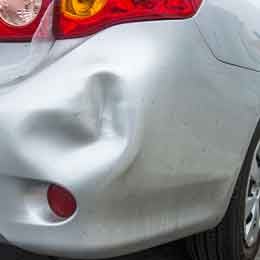 Have you ever come out of a store or restaurant and noticed your car has a new look? No, I’m not talking about your spouse or significant other surprising you with a new car. I’m referring to a large dent or scratch that wasn’t a part of your car before you parked it.
Have you ever come out of a store or restaurant and noticed your car has a new look? No, I’m not talking about your spouse or significant other surprising you with a new car. I’m referring to a large dent or scratch that wasn’t a part of your car before you parked it.
If so, you’ve experienced a hit-and-run accident. Hit-and-run accidents can involve cars, pedestrians, or other property.
So does auto insurance provide coverage for a hit-and-run? The answer to this question is, “It depends.”
Two insurance coverages that provide protection are comprehensive (other-than-collision) and collision.
Collision coverage pays for damages to your car caused by a collision with another car or object, or by turning upside down.
Comprehensive coverage pays for damages to your car because of fire, falling objects, wind, hail, earthquake, explosion, or vandalism.
If your car is parked in a parking lot and is hit by another car, collision will provide coverage.
Kids vandalizing your car while parked outside your home or in a parking lot is covered under comprehensive.
As your car ages, and your loan is paid off, it may seem like a good idea to drop or reduce coverage from your policy. While this will reduce your premium, it does transfer the risk back to you. Therefore, in the parking lot scenario mentioned above, you may be responsible for the costs to repair your car.
Tips on how to handle a hit-and-run accident
1. Stay calm.
Seeing your damaged car can be shocking and upsetting. Take a moment to collect your thoughts.
2. Capture information about the car that hit your car.
If you see the car that hit you and it sped off, try to record the make, model, and license plate number.
3. Identify possible witnesses.
If you see other people around your car, ask if they witnessed the accident. Also, look around for surveillance cameras. Surveillance footage may be able to show what happened.
4. Collect information at the accident scene.
This information can be helpful when talking to the police and your insurance company. It should include:
- Date, time, and location;
- Pictures of your car; and
- Pictures of the accident scene.
5. Don’t chase the driver.
Chasing the driver who hit your car is never a good idea as it can put you and others in a very dangerous situation. Contact the police immediately. A police report can help the claim filing process.
Do you have any suggestions or information you’d like to share? I’d love to hear from you. Please share them in the box below.
This article is intended for general educational and illustrative purposes only and should not be construed to communicate legal or professional advice. Further, this article is not an offer to sell insurance. Please consult with your licensed insurance agent for specific coverage details and your insurance eligibility. All policies are subject to the terms, conditions, limitations, definitions, and exclusions contained therein.





